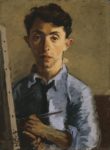
Raphael Soyer
Russian, 1899-1987 (active USA)
Dreams, 1970
lithograph
26 x 19 in.
SBMA, Gift of Mr. and Mrs. Samuel Dorsky
1973.18.5

Self portrait of Soyer from c.1927 @ the Phillips Collection
Classifying himself as a representational artist, Raphael Soyer uses art to fulfill the most constant of human needs: depiction and expression of the dreams as well as the realities of ordinary human beings. In contrast to the abstractionists, Soyer describes his art as "constructive, life-preserving, aiming to transform the destructiveness of this {world}, to give us a better reality, a better life."

Photo of Soyer in his studio by Alfredo Valente, 1940
COMMENTS
Raphael Soyer was born in Tambov, Russia. He moved to the United States when he was thirteen years old. His father was a large influence on Soyer: the two of them often drew together on Sundays. The young Soyer was intrigued that he could make a flat surface have the illusion of depth. He completed his first etching in 1917. Soyer studied at the Art Students League with Guy Pene du Bois, and at Cooper Union (1914-17) and the National Academy of Design (1918-1922). He taught at the Art Students League, the American Art School (NYC), the New School for Social Research, and the National Academy of Design. He produced realistic depictions of daily life, and painted a WPA mural at the United States Post Office in Philadelphia. His style changed over the years, from a flat style to a more liberated one that echoed the work of Edgar Degas. During the Depression, many of his works were executed in a Social Realist style and frequently depicted street vagrants. Later, his primary subjects were women working or posing in his studio. He also published several books, including "A Painter's Pilgrimmage" in 1962 and "Diary of an Artist" in 1977. Retrospectives of his work were held in 1967 at the Whitney Museum of American Art, and in 1982 at the Hirshhorn Museum.
His made numerous portrayals of women, each of which reveals his understanding of and sensitivity to women and their everyday roles. He does not deify them nor does he stereotype them. Instead, he reveals his veneration by peering into their souls and recording nuances of the inner makeup through his representation of characteristic poses drawn from real-life scenes.
As in all of his works, his identification with suffering, expressed in objective terms, reflects his affinity for his subjects as well as for Russian realists such as Tolstoy. Having been raised in New York City, Soyer was very familiar with the common life and sought to depict not the fashionable denizens of culture, but rather shop girls, office girls and shoppers: women who had done battle with the harsher realities of life.
What is most notable about his representations of working women is his ability to convey their wholeness. His subjects are multi-dimensional individuals who often stoically endure life abuses. Interestingly, when a man and woman are portrayed together, the woman appears dominant and the rapport between the two seems markedly strained, with each involved in his or her separate world; alternatively, when women are shown together, a common bond appears to unite them and transcend objective differences.
Concerned chiefly with truthful presentations, Soyer avoids adornment and attempts to portray the scene as he sees it. His figures, whether they are friends or strangers, often lack beauty and yet exude a realness that transcend conventional classifications.
While his early works can be classified as primitivism, by 1929 his forms were deftly crafted and he was using light and shadow to produce sharp-edged, full-bodied subjects.
ashevilleart.com
blair-murray.org
